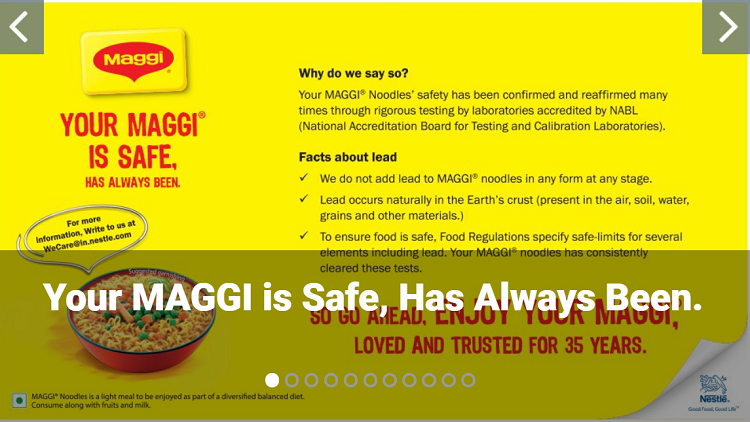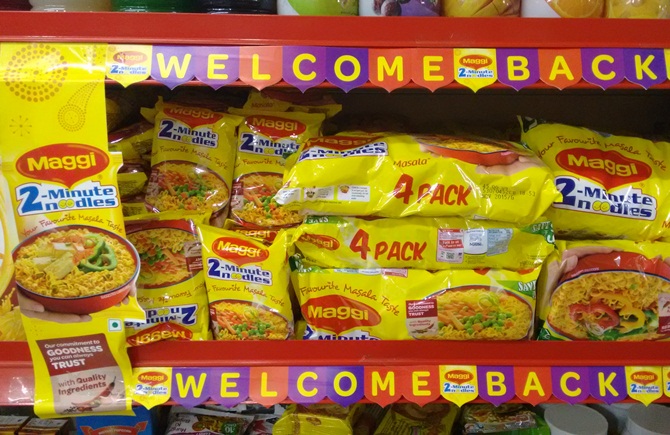Maggi is a well-known brand that everyone knows. It is a brand that needs no introduction. Since 1947, the Nestle brand has included instant noodles, seasonings, and soups. Among all of its products, Maggi was the first to introduce protein-rich vegetable dinners to the market, followed by prepared soups. 1983 was a watershed moment in Indian history since it saw the introduction of Maggi instant noodles.
Maggi has typically remained in the spotlight for its flavor, and it has become the preferred snack of the majority of India’s people. Maggi, on the other hand, was in the news for a variety of reasons at one point in time. The major reason was poor promotional activity owing to the presence of monosodium glutamate (MSG) and dangerously high levels of lead in the packets examined by FSSAI. The customer’s trust was shaken as a result of this. As a result of this uproar, many parts of society were concerned due to the involvement in the health of children in this case.

In what way the commotion originated?
After the proximity of pesticides in soda, the Nestle Maggi two-minute noodles emergency has ballooned up as India’s most exceptionally awful nourishment concern. The uproar over Maggi, one of India’s most popular snacks, drew attention owing to rising consumer health concerns.
Maggi noodles were sued in India for alleged violations of food security standards following a test by a state government lab that discovered the presence of MSG (a chemical that Nestle stated it did not put to their item) or higher levels of lead. Regardless, they rejected these results, despite the fact that further testing by administrative labs in several states revealed conflicting results. Despite the company’s confidence in Maggi’s safety, the Delhi municipal administration imposed a ban, signaling that other state governments should follow suit.
The disappearance of Maggi was a significant disappointment for Indian customers who still had a soft spot for the product and were unable to let it go. The fall of Maggi was not caused by any external causes, but rather by the product’s inherent characteristics, such as an increase in lead content, which harmed customer health. Nonetheless, despite the product’s dramatic decline, Maggi survived. They turned this catastrophe into a learning experience for their future endeavors. Maggi recovered its shelf position by thoroughly rechecking its product and its components.
Maggi has held the market top position since its inception. However, Maggi’s fall phase saw the development of then-market followers contending for the position of market leadership.
The re-emergence of Maggi in the market drove its competitors to second place, recovering and retaining market leadership due to the overall influence that it has always had on the Indian market. Nestle has been on a firefighting strategy since the Maggi disturbance became press headlines, by making this crisis scenario a point of learning for their future endeavors. Without a doubt, the brand’s reputation was harmed; it took some time for the brand to restore its strength and return to the shelves, leaving all of its competitors in the dust.
Discussion of Maggi
Pre-ban period
From the government to law enforcement, there was an all-out onslaught against Maggi. The government of India has filed a claim for damages from settle after allegations of excessive lead and MSG (a flavor enhancer) in Maggi prompted a nationwide inquiry. They become heated up over Nestle Maggi 2-minute noodles being hailed as India’s worst nourishment apprehension in ten years, following the presence of chemicals in soda pops. It was a real issue of general wellness, and the legislation allows us to take self-made legal steps against blundering’s elements official from the national purchaser question redressal commission.
Following recurrent quality testing and meetings with settle supervisors, the Food Safety and Standards Authority of India (FSSAI) ordered a nationwide assessment of the Maggi.
Reporting of the issue in social media
As the feud between Nestle and the FSSAI heated up, TV channels, newspapers, and other social media platforms in India gushed over Maggi as if it were one of the year’s greatest stories. News stories were released with headings such as, “Maggi under regulatory scrutiny for lead, MSG above permitted limits; Maggi treachery has crushed our good Indian hearts; Maggi demonstrates Indian customers are taken for granted,” and so on. The emotional connection with Maggi at its customer interaction, along with the uproar over contradicting test results and the public’s lack of awareness about food regulations, gave the media a chance to sway public opinion. Maggi was subjected to a media trial prior to its seizure.
Just as conventional media reported the topic widely, social media exacerbated it. The growth in the dominance of social media players such as Facebook and Twitter has aided in the transmission of news, regardless of its validity.
This has apparent ramifications for Nestle: a heated debate on a contentious topic might spread quickly.
Maggi sales have dropped, with big metropolitan stores reporting a 15% to 20% drop. Nestle India’s shares plummeted 15% between mid-May and early June.
Ban period
Nestle Maggi has been in firefighting mode since the news broke about unsavory additives in Maggi. The brand’s reputation suffered greatly as a result. Maggi noodles sales have suffered significantly when it was discovered that the samples examined by government laboratories included unnecessary substances such as lead and MSG.
Because of the Maggi prohibition, the manufacture of Maggi ceased, affecting suppliers. Around 1500 people in India involved in the production of Maggi were impacted by the suspension of production following the Maggi ban. The impact of Maggi’s demise was felt by the stock market as well.

After ban
Maggi has long been one of India’s most popular snacks. It was typically kept in the news for its flavor.
During the prohibition time, the organization did not dismiss any of its changeless laborers but rather engaged them in various activities like planning, group development, and so on.
However, it should be noted that definite procedures, values, and ethics have varied meanings for different types of businesses. Maggi has long been a market leader, accounting for 80 percent of the consumer market. Market leaders are frequently perceived to be able to create their brands and utilize their brands based on well-defined procedures within the company in order to persist.

Relaunch of Maggi
On October 26, Nestle resumed assembling Maggi noodles, which entered the market after receiving approval by food testing labs. Nestle reintroduced Maggi noodles to the market after the Bombay High Court removed restrictions on all nine Maggi varieties.
Within seven days of Nestles Maggi noodles being reintroduced to the market, the nation’s main nutrition controller – FSSAI – moved the supreme court against the Bombay high court’s order that allowed the noodles to be reintroduced. However, it should be noted that Maggi passed the first round of testing on October 16, 2015, allowing Nestle India to continue manufacturing the item. The second round of tests on newly manufactured groups also declared the item safe for human consumption. At regular intervals, a few Maggi samples were tested.
Snapdeal sold 7,20,000 units of Maggi noodles (twelve-packs) at its debut, with 60,000 units sold (welcome unit). These well-received packages included a Maggi date-book 2016, a Maggi ice chest magnet, Maggi postcards, and a welcome return note. It quickly grew to 3.9 million retail locations.
Also Read: Tropicana Rebranding Failure
Conclusion
A market-based crisis may occur as a result of numerous reasons such as economic, political, socio-cultural, technical, and competitive pressures. These variables impact the shift in market operations, necessitating a change in the firm’s actions. They function as an influence and determine their severity depending on the influence’s breadth, degree of impact, range of impact, response gap, the timing of interaction factors, and so on.
To read more content like this, subscribe to our newsletter.



